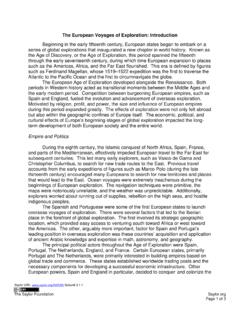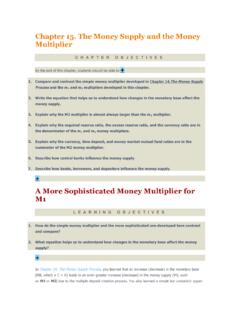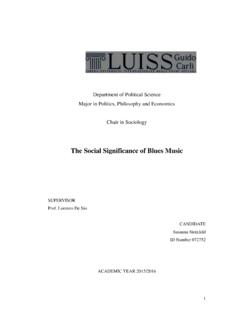Transcription of The Ante-Bellum South: Life on the Plantation
1 The Ante-Bellum south : life on the Plantation Henry J. Sage (2010). For in a warm climate, no man will labour for himself who can make another labour for him. This is so true, that of the proprietors of slaves a very small proportion indeed are ever seen to labor. And can the liberties of a nation be thought secure when we have removed their only firm basis, a conviction in the minds of the people that these liberties are the gift of God? That they are not to be violated but with his wrath? Indeed I tremble for my country when I reflect that God is just: that his justice cannot sleep for ever .. Thomas Jefferson Notes on the State of Virginia The story of life on the slave Plantation in the antebellum south has been told, retold, and told yet again as historians have struggled to wrestle the truth out of a reality that was difficult to understand even in its own time.
2 While a great deal has been written about the history of the peculiar institution, uncovering the details of life among the slave population has proved to be elusive, for various reasons. First, the history of slavery in the American south was often portrayed inaccurately both by those familiar with the institution and those opposed to it. The strongest defenders of slavery saw it as a positive good and in keeping with God's order of things. Those who sought to abolish slavery condemned it as an unmitigated evil. From both ends of that spectrum, exaggerated descriptions of slavery were likely to occur. In fact, there is no single description of slavery that suits every situation or every region of the south . Slavery in the border states of Source URL: # Plantation Saylor URL: Unit Henry J.
3 Sage Used by permission. Page 1 of 16. Maryland, Virginia and Kentucky, for example, was not likely to be as harsh as slavery in the deep south , farther from free territory, in areas where larger plantations existed. To complicate the matter further, interpretations and reinterpretations of the history of slavery have been driven by scholarly and social trends, with the result that descriptions of the institution have often been biased in favor of the point of view of the writer. In addition, while voluminous records of life in the south exist, those records are incomplete or under- representative of certain aspects of slavery. For example, the large majority of slave owners owned relatively small farms and few slaves. The average number of slaves per Plantation was about ten, but that number must be reckoned against a substantial number of plantations on which a hundred or more slave laborers existed.
4 On smaller plantations there was a high likelihood that the Plantation owner might been less than fully literate or too busy to keep detailed records. The small slave-owner's relationship with his slaves was likely to be less harsh than on farms where larger numbers of slaves were supervised by overseers responsible to the master. Furthermore, records of mistreatment of slaves, beatings of slaves of both sexes, the rape of slave women and other abuses were unlikely to be recorded in detail, if at all. In the years both before and after the Civil War, a mythology grew up around the institution of slavery in the south . The image portrayed in the famous 1939 film Gone with the Wind, with the kind Massa looking after his contented darkies, surrounded by gallant young men and radiant Southern belles, each attended by a loving black Mammy.
5 Persisted for generations. A passive slave culture persisted in the minds of many, but the reality was that slavery was almost always harsh and cruel under the best of circumstances. Another image of the antebellum south was of the poorest whites, often Source URL: # Plantation Saylor URL: Unit Henry J. Sage Used by permission. Page 2 of 16. called crackers or poor white trash, who lived in ignorance and degeneracy in a system that depended upon slavery. Many of those poor whites lived in the hill country away from the cotton areas. Their existence was affected by poor nutrition and resulting bad health. Although they had no stake in the slave system, they nevertheless supported racial division because despite their lowly status, they were still able to look down on blacks.
6 A reasonably prosperous middle-class of white farmers and businessmen also contented themselves with the labor system of the south , as many of them hoped to move into the slave-owning planter class when they became prosperous enough. Because the bulk of Southern capital was invested in land, cotton and slaves, the Southern economy had distinct features that centered around life on the Plantation . Both black and white women had considerable responsibilities in running the Plantation The image of a leisurely life for wives of prosperous Plantation owners belongs to the mythology of the Southern culture. Because slaves were valuable property, the white women on the Plantation family were obliged to devote their time to the care of their slaves, often administering basic medical treatment and assisting with the births of slave children.
7 The irony of the reality that children born to slave women often had white fathers, who might be husbands or sons of the Plantation mistress, was generally suppressed;. such wives generally suffered in silence. Source URL: # Plantation Saylor URL: Unit Henry J. Sage Used by permission. Page 3 of 16. What evidence we have of life among slaves comes to us from reporters both black and white who were articulate enough to make records of slavery as they saw it. One of the most famous eyewitness records was that of Frances Anne Fanny Kemble, an English Shakespearean actress who met and married the wealthy Philadelphian, Pierce Butler, while on tour. Butler's wealth derived from a large family slave Plantation in Georgia, and when Fanny Kemble first visited the Plantation with her husband, she was shocked and dismayed by what she saw.
8 She wrote voluminous letters to friends and kept a journal which was suppressed for some years and finally published in 1863. Once in print, Mrs. Butler's journal provided a vivid and sympathetic picture of slave life ; her descriptions vary between horror at the treatment of slaves, especially slave women who were often required to work long hours even while pregnant or shortly after childbirth, and her frustration with the miserable deportment of the slaves she encountered. Her inability to accept her husband's role in the practices of slave-owners contributed to the reasons for their divorce. Source URL: # Plantation Saylor URL: Unit Henry J. Sage Used by permission. Page 4 of 16. Frederick Douglass and Booker T. Washington have also provided well- known accounts of their lives in slavery.
9 Many slave narratives, often transcribed by literate blacks or sympathetic whites, have also been published. As part of the civil rights movement of the 1960s, historians took a fresh look at African-American history and at the institution of slavery. They attempted to filter out the mythology and error in order to arrive at a semblance of truth. Attempts to right past wrongs, either of historiography or of actual historical situations, often caused the pendulum to swing past center. That is not to say that deliberate distortions were frequent, only that the most extreme conditions of slavery were often described in the greatest detail. The result of what some saw as excessive reinterpretation was that yet another round of defenses of the institution of slavery made their appearance.
10 Perhaps the best way to arrive at a satisfactory understanding of the institution of slavery is to acknowledge that it was for many slaves, in the words of Fanny Kemble, a huge misery. Although slavery in some form had been part of human societies from the earliest times, by the mid-19th century the very idea of owning another human being as a piece of property had lost legitimacy. Even a society as backward as that of Russia had ended chattel slavery by 1861. And while it is undoubtedly true that many human beings existed in horrible economic straits, in conditions that were in certain ways just as cruel as those of slavery, one's permanent status in that condition was hardly institutionalized. It is also true that within the slave culture of the American south , the full span of human relationships was undoubtedly present.











